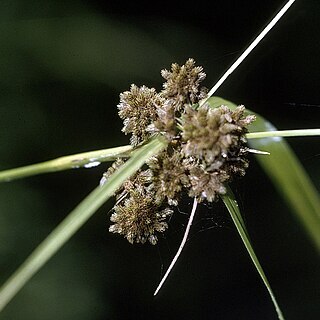Leafy tufts 60-150 cm high. Stems stout, 3-angled, leafy at base and with 3-5 evenly spaced cauline leaves. Leaves < stems, 5-10 mm wide, double-folded but flattened, margins very finely scabrid. Inflorescence a terminal compound irregular umbel with unequal erect rays 1-10 cm long, secondary rays widely spreading, often almost at right angles; leaf-like bracts c. 3, longest usually > inflorescence. Spikelets ± 3 mm long, ovate, in clusters of 5-10 at tips of rays. Glumes ± 1.5 mm long, dark brown, membranous, with a thick green excurrent midrib. Hypogynous bristles 0 in N.Z. specimen [present or absent in American Plants]. Stamens 3. Stigmas 3. Nut slightly < 1 mm long, ellipsoid, trigonous with slightly thickened angles, shining, cream.


